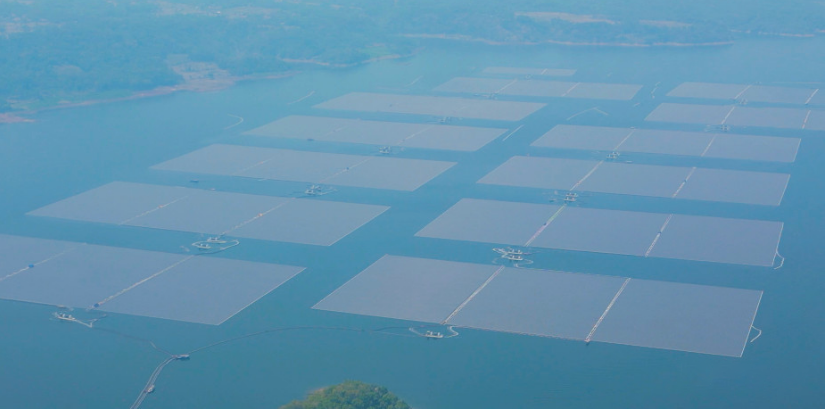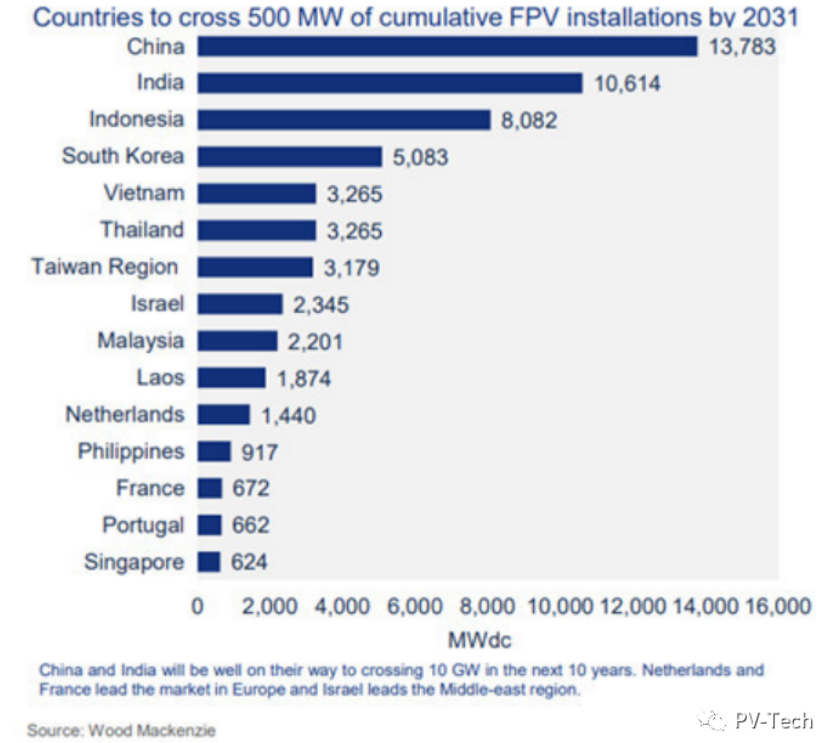
- English
- Español
- Português
- русский
- Français
- 日本語
- Deutsch
- tiếng Việt
- Italiano
- Nederlands
- ภาษาไทย
- Polski
- 한국어
- Svenska
- magyar
- Malay
- বাংলা ভাষার
- Dansk
- Suomi
- हिन्दी
- Pilipino
- Türkçe
- Gaeilge
- العربية
- Indonesia
- Norsk
- تمل
- český
- ελληνικά
- український
- Javanese
- فارسی
- தமிழ்
- తెలుగు
- नेपाली
- Burmese
- български
- ລາວ
- Latine
- Қазақша
- Euskal
- Azərbaycan
- Slovenský jazyk
- Македонски
- Lietuvos
- Eesti Keel
- Română
- Slovenski
- मराठी
- Srpski језик
Southeast Asian countries invest in building floating photovoltaic power stations
2023-11-29
The installed capacity of floating photovoltaic power generation (FPV) continues to rise. A report released earlier this year by energy research company Wood Mackenzie predicted that by 2031, the global installed capacity of FPVs will exceed 6GW.
However, Asian countries will develop more FPV projects than European countries, and by 2031, the cumulative installed capacity of FPVs in 11 Asian countries will exceed 500MW.
Wood Mackenzie consultant Ting Yu believes that the increase in land costs for available land and ground solar projects is the reason why solar developers are shifting towards FPVs. Therefore, compared to the total global demand for solar energy, the market share of FPVs will remain stable. It is expected that the compound annual growth rate (CAGR) of FPV will increase by 15% in the next decade.
Installing solar panels on the surface of water bodies has many benefits. The solar modules installed on the water surface have lower temperatures, resulting in higher efficiency, and the shading effect of the solar modules can reduce water evaporation, thereby protecting drinking or irrigation water.

Southeast Asia FPV Potential
From a regional perspective, Asia is expected to lead the demand for FPVs. By 2031, the cumulative installed capacity of FPVs in 15 countries will exceed 500MW, with 11 countries located in Asia. Among these 11 countries, Southeast Asia accounts for 7.
Among them, Indonesia has the highest FPV installed capacity, reaching 8.08 GWdc by 2031, followed by Vietnam (3.27 GWdc), Thailand (3.27 GWdc), and Malaysia (2.2 GWdc).
When it comes to the development of FPV projects in Asia, Wood Mackenzie's electricity and renewable energy research analyst Daniel Garasa Sagardoy said, "There are two main factors, which are related to the lack of land and available water bodies. Compared to ground photovoltaics, the FPV market has a higher cost of levelized kilowatt hours of electricity, higher capital expenditure, and lower power generation. In Asia, the extremely high population density, the necessity of using land for agriculture, and the growing demand for electricity all stimulate the development of FPVs."
According to the Southeast Asian FPV Technology Potential Assessment conducted by the National Renewable Energy Laboratory (NREL) in the United States, Southeast Asia has 88 reservoirs and 7231 natural water bodies, excluding water bodies located more than 50 kilometers from major roads and within protected areas.
Due to the availability of a large amount of water, the FPV potential of reservoirs in this area is 134-278GW, and the FPV potential of water bodies is 343-768GW.
In fact, the FPV potential of Southeast Asian countries can help the region achieve its renewable energy goals. The Association of Southeast Asian Nations (ASEAN) has set a regional target of 35% renewable energy installed capacity by 2025.
Indonesia FPV
Earlier this month, Indonesia held a groundbreaking ceremony for the 145MWac (192MWp) Cirata floating solar power plant located in West Java Province. Indonesia's State Grid Corporation (PLN) and Masdar, a state-owned renewable energy developer in the United Arab Emirates, claim that the project is the "largest" FPV project in Southeast Asia.
Prior to the completion ceremony, Masdar and PLN signed an agreement in September to expand the production capacity of Indonesia's 145MW Cirata floating photovoltaic project to 500MW.
The FPV project is built on a 250 hectare plot of land in Cirata Reservoir. Arifin Tasri, Minister of Energy and Mineral Resources of Indonesia, stated that if 20% of the total area of the Cirata Reservoir can be utilized, the potential of this project could reach approximately 1.2 GWp.
At the same time, NREL's Southeast Asia FPV Technology Potential Assessment Research Report points out that due to its abundant water resources, Indonesia's FPV technology potential is as high as 170-364GW, ranking among the top among all Southeast Asian countries. According to data from the International Renewable Energy Agency (IRENA), Indonesia's potential FPV installed capacity is even much higher than the total electricity installed capacity of 74GW in 2021.
The Indonesian government has stated that according to the Comprehensive Investment and Policy Plan (CIPP), the potential installed capacity of FPVs will exceed 28GW. CIPP has proposed a plan to significantly increase various forms of solar photovoltaic power projects, with the goal of achieving a power capacity of 264.6GW by the middle of this century.
Indonesia has multiple characteristics suitable for constructing FPV projects due to its terrain. Indonesia is mountainous, with developed agriculture, numerous water bodies, and a continuously growing population, which means that FPV provides an effective way to improve deployment rates.
Philippine FPV
In August of this year, SunAsia Energy, a solar energy design, procurement, and construction (EPC) company, announced the construction of a 1.3GW FPV project on Laguna Lake, the largest lake in the Philippines. The project's usage area (1000 hectares) accounts for approximately 2% of the Laguna Lake area (90000 hectares).
The project is expected to commence construction in 2025 and gradually enter operation from 2026 to 2030.
In addition, the energy platform ACEN plans to develop 1GW FPV on the same lake. Through a renewable energy signing agreement, ACEN has signed an 800 hectare lease with the Laguna Lake Development Authority to develop an FPV on the largest freshwater lake in the Philippines.
NREL stated that the FPV capacity range of natural water bodies in the Philippines is between 42-103GW, far higher than reservoirs with a potential capacity of 2-5GW.
Thailand FPV
In Southeast Asia, Thailand also has relatively high potential in the FPV field. NREL stated that Thailand has a technological potential of 33GW-65GW in the field of reservoir FPV and 68GW-152GW in the field of natural water bodies.
In November 2023, Huasheng New Energy signed a framework agreement with Thai design, procurement, and construction company Grow Energy in Bangkok to provide 150MW heterojunction (HJT) components, of which 60MW components will be delivered to the FPV project in Thailand.
Two years ago, Thailand also launched a 58.5MW FPV project. This solar energy project is co located with a hydroelectric power station, covering an area of 121 hectares, on a reservoir in Ubon Ratchathani, northeast Thailand.

Differences between Asia and Europe
PV Tech Premium reports that although Europe faces more obstacles in developing floating photovoltaics, floating photovoltaics can play a role in the energy transition of some EU countries.
Sagardoy stated that licensing procedures and environmental issues are the main obstacles and added that some countries have banned the construction of floating photovoltaic projects in natural lakes, while others have also restricted the percentage of water coverage.
For example, Spain attempted to regulate the installation of FPVs on reservoirs last year and released a list of requirements primarily based on water quality. The FPV project must be temporary and must not exceed 25 years in duration.
Although FPV will not become a key pillar of the EU's transformation, it will still play a role in the Netherlands and France. For example, SolarDuck, a Dutch Norwegian FPV company, has been selected as an offshore FPV technology supplier for a hybrid power plant in the Netherlands.
As part of the bidding for the Dutch Kust West VII offshore wind power plant, RWE has granted SolarDuck exclusive supply rights for offshore FPVs (with energy storage). They will build a 5MW FPV demonstration project and plan to put it into operation in 2026.
In France, in a tender in June 2022, renewable energy producer Iberdrola won the bid for a 25MW FPV power plant.
PV Tech Premium also discussed the progress of FPV technology earlier this year.



